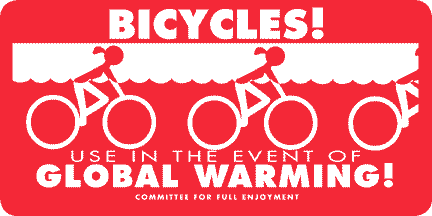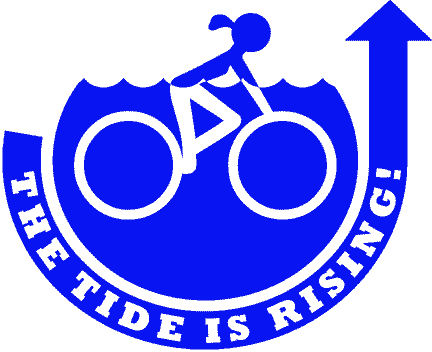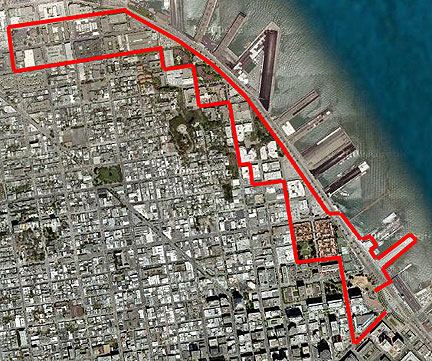Been way too busy with the book project (Ten Years That Shook the City: San Francisco 1968-1978) and a fascinating oral history project (“Ecology Emerges”) that has had me doing sixteen interviews in the past few weeks… sorry for my poor blog here, which has lost out in the tussle for my time… anyway, wah wah wah.

These are now available from me via my personal website... perfect for hanging on your bike as the oceans rise!
I’m planning to be in Copenhagen at the Climate Conference (not inside, but outside) in December, and along with a whole lot of other folks on the planet, I’m thinking more and more about the dire facts piling up… We’ll be riding this Saturday in San Francisco along one possible future shoreline, as part of the thousands of actions across the country clamoring for meaningful policy change on Climate Change. We’re hosting a Talk next Wednesday at CounterPULSE on “Climate Change/Climate Justice” and I hope a lot of folks will come out for it.
I’ve been expecting to see a major rise in ocean levels in my life time, in spite of the commonly cited figures of a meter rise by 2100 or even less. I think it’s all going a lot faster than anyone can measure, and the synergistic reactions among different factors, like melting ice sheets, thawing arctic tundra, etc., are coalescing into a perfect storm. Inundation of coastal areas seems like it could happen rather suddenly, like within 10-20 years. Here’s a piece I came upon today that drives it home with a bit more science:
And what of that lodestone, global sea level? This happens to be a very interesting question, because ocean levels are set to rise dramatically. According to UCLA scientists, the last time carbon dioxide levels were as high as they are today was 15 million years ago. At that time, the sea level was between 20 and 36 metres higher (75 to 120 feet), there was no permanent ice cap in the arctic, and very little ice in Antarctica or Greenland. That is where we are headed. The only remaining question is, How long will it take us to get there?
The authors of the Hadley Centre report predict a rise of just 1.4 metres by 2100. The IPCC in their 2007 4th Assessment Report predicted something like half a metre by 2100 based on a combination of the fattening of the oceanic envelope caused by thermal expansion and the increased runoff from glaciers and minor ice sheets. None of this sounds particularly catastrophic just yet, but then it turns out that these predictions are not based on anything particularly relevant: the British Antarctic Survey, in 2008, made it clear that the IPCC had not included the source of nearly 100% of the world’s potential ice melt ““ the major ice caps of Antarctica and Greenland ““ simply because they had little idea of how the ice caps would behave in a heating world:
The Intergovernmental Panel on Climate Change (IPCC) highlighted the issue by suggesting that current knowledge is inadequate to estimate confidently the contribution that ice sheets might make to sea-level rise in coming centuries. While technology makes sea-level rise easier to observe, and we can predict some contributions to future sea-level rise with increasing certainty, we cannot yet fully predict the ice sheets’ contribution. There is thus a risk that sea-level rise could be higher than the (incomplete) estimates provided by the IPCC.
Thus, the most peer-reviewed piece of climate science ever written turns out to be completely inadequate when it comes to estimating the level of disruption associated with a very important aspect of climate change: the rising seas. If Antarctica contains 90% of the world’s land ice (sea ice, like that in the Arctic, does not directly cause the oceans to rise when it melts) and Greenland contains most of the rest, then what’s going to happen when they start to melt with a vengeance, and when are they going to start melting? Official science is mute on the subject.

Our logo for Saturday's ride.
It’s hard to figure out how to address this and what to do… I wrote this up today, to be distributed as a handbill on Saturday:
We are bicycling along one of many future shorelines of San Francisco to dramatize the inevitable rise in oceans and the subsequent inundation most coastal cities will face due to catastrophic human-induced climate change. As we approach the December global climate summit in Copenhagen, we ride today in solidarity with thousands of others around the planet, demanding real action” not bogus market-oriented, cap-and-trade, smoke-and-mirrors inaction. Drastic reductions in carbon emissions are a straightforward and urgent necessity, and will not be achieved by auctioning off the last true commons, our skies.
We bicycle, too, to demonstrate one of the many ways we can change our daily lives towards a just world that provides a good life to everyone as a matter of right. Addressing the climate involves the way we live as much as it does planet-wide agreements on technology and public policy. The failure of the U.S. to enact strict federal rules to promote clean, green technologies and restrict, reduce and eliminate dinosaurs like coal, oil and nuclear is paralleled by a failure of imagination among activists here. Too many of us think we can solve the ecological crisis by recycling more, or shopping responsibly, while continuing to rely on fossil fuels in other areas of our lives.
Join us in raising the temperature of public pressure. Industrialized food production, a auto-centric transit system, oil dependency, and a long list of bad technological choices cannot be solved by simply committing to good shopping. They require a sudden, dramatic, and forceful shift at the national and state levels. This inevitable shift cannot be made at the expense of those who have already been left behind or left out, subjected to polluting factories, toxic waste dumps, power plants, and incinerators. We can create a healthy, prosperous life for everyone” not just in the Bay Area” but across the country, and crucially, across the world. You can start changing how you live by using less energy, water, and resources. But we also can’t leave power in the hands of the same business and government leaders who have profited so handsomely from the mess they’ve already made.
Committee for Full Enjoyment, Oct. 24, 2009
Get active!:Â Â ActForClimateJustice.org/West

Our route.
Join us at 2 p.m. on Saturday, Oct. 24 on the lawn just south of PeeWee Herman Plaza in San Francisco (more or less the end of the red line that leaves on Market Street).
Lastly, the oceans rising are only one part of a larger problem of our inability to live intelligently on earth. One of the ongoing dramas that is way out of sight and out of mind is the mid-Pacific gyre, the immense pile of plastic soup that fills a space said to be twice the size of Texas, where countless millions of pounds of plastic are slowly decaying in the sea. A friend just sent me this link to some really stunning photos of dead Albatross chicks on Midway Island, 2000 miles from any continent. They more than eloquently speak for themselves. Brace yourself and have a look…












this is my first visit and I just wanted to stop by to say hi all!